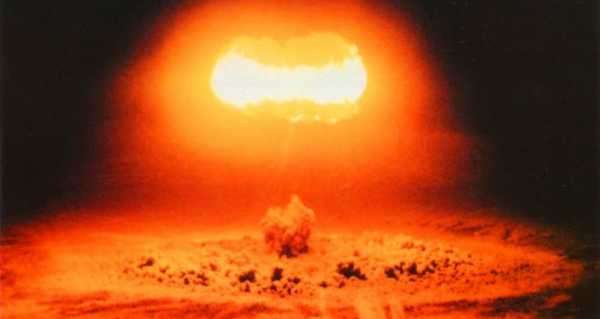
Since 2019, the US has invested billions in developing new ground-launched missile systems like those that helped provoke a nuclear war scare in November 1983, but were subsequently banned as being too dangerous to the peace.
Newly released documents from the US State Department reveal the degree to which Soviet leadership believed a provocative, ultra-realistic NATO war-game in late 1983 was a cover for a genuine nuclear first strike against the Soviet Union.
The National Security Archive says it fought for years to get the documents, including an all-important report from 1989 by Lieutenant General Leonard H. Perroots, the intelligence chief for US Air Forces in Europe during the drills. The archive noted that the Defense Intelligence Agency had long claimed the memo was “lost,” but State Department historians later uncovered the file in the CIA’s archives.
Perroots’ memo reveals that the tit-for-tat situation that resulted during the war games, as each side upped the ante with an increasingly aggressive posture, was much closer to exploding than the public realized, or than the Pentagon admitted. Clearly, the Soviets were not simply posturing, but feared that a nuclear strike by the United States and its allies was extremely likely in the coming hours and days.
‘Calculated to Induce Paranoia’
The Soviet fears were not idle: years of psychological operations had prepared the ground by driving up Soviet anxieties. American bombers would practice attack runs, peeling of at the last minute as Soviet radar sites sounded the alarm; American submarines would push the limits of how close they could sneak to Soviet naval installations; and most importantly, dangerous new missiles were being stationed in Europe that make a nuclear first-strike seem almost possible: the Pershing II medium-range ballistic missile.

Pershing II missiles
The first of hundreds of Pershing IIs were expected to begin arriving in West Germany in late 1983, around the time of the Able Archer war game.
More events further turned up the tensions. In April of that year, a US Navy strike group of 40 warships approached the Russian Far East in a war posture, jamming Soviet radars and making practice runs on Soviet radar sites on the mainland. Then, in early September, a Soviet interceptor shot down Korean Air Lines Flight 007 in Soviet airspace, killing 269 civilians, including a sitting US congressman, after mistaking the airliner for a US spy plane also flying in the area. Later that month, an error in a Soviet radar site seemed to show a nuclear missile launch from the United States, with preparations for a counter-strike only being averted by a mindful commander who suspected the computer was wrong.
Then, in the last week of October, the US launched an invasion of Grenada, overthrowing the socialist New JEWEL movement due to its growing friendliness with Cuba and other socialist nations, including the USSR.
On Nuclear Alert
All this is why on November 3, 1983, NATO launched the most realistic war games they had ever performed, the Soviets were already on-edge. The war games simulated a steady escalating conflict, beginning with massive troop deployments across the Atlantic and the assuming of attack postures by NATO forces in Western Europe, and finishing with a DEFCON-1 declaration signaling imminent nuclear warfare. The drills employed never-before-seen codes, troop movements made under radio silence, and even involved West German Prime Minister Helmut Kohl and UK Prime Minister Margaret Thatcher.

MiG-27 from No.18 Squad, Kalaikunda
Perroots wrote that after being placed on constant heightened alert, the fighter-bomber divisions were also ordered to ready one squadron of each regiment to “destroy first-line enemy targets.” This, he notes, would total roughly 108 aircraft spread across East Germany and Poland.
Further air photography identified at least one aircraft, a MiG-27 (NATO reporting name Flogger) strike aircraft “fully armed” on defense alert at an East German base. Other aircraft that would have been equipped with nuclear weapons include the Su-17 (NATO reporting name Fitter).

Soviet Su-17s take off from Groß Dölln air base in the German Democratic Republic
Another document in the dossier, a lengthy 1990 report to the Foreign Intelligence Advisory Board of then-US President George H.W. Bush, noted that in 1983 ”we may have inadvertently placed our relations with the Soviet Union on a hair-trigger.”
Now-Shredded INF Treaty Aimed to Avoid a Repeat
After Able Archer ended on November 11 without incident, Soviet forces stood down from their alert. In the aftermath, US President Ronald Reagan began to take a more moderate diplomatic posture, and four years later, the two nuclear superpowers agreed to the Intermediate-Range Nuclear Forces (INF) Treaty, which banned weapons like the Pershing II.

This US Department of Defense (DOD) handout photo shows on August 18, at 2:30 p.m. Pacific Daylight Time, when the Defense Department conducted a flight test of a conventionally configured ground-launched cruise missile at San Nicolas Island, California. – The test missile exited its ground mobile launcher and accurately impacted its target after more than 500 kilometers of flight. Data collected and lessons learned from this test will inform DOD’s development of future intermediate-range capabilities.
In 2019, the Trump administration pulled out of the INF Treaty, claiming Russia had violated its terms by introducing the Iskander ground-based missile Russia has denied these claims, saying its range did not violate the treaty. However, just days after the treaty lapsed in August 2019, the US began testing its own missiles that would have violated the treaty, and now has several such weapons in development.
Sourse: sputniknews.com






